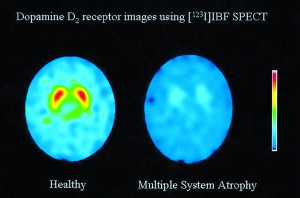Synchrony of waves helps regulate the brain and behavior.
Thanks to a parent who passed on a recent NY Times article about adult ADHD, and how some people seem to “grow out of it.” (See “A Natural Fix…”) The article described research being done at MIT, where researchers have found another tool to diagnose ADHD medically: look to see if the resting brain has a “default mode” where several regions of the brain are interacting with each other.
This work is based on the premise that we have “brain waves“. What is a brain wave? Believe it or not, you’ve got electricity in your brain! Your neurons are constantly pumping ions across their membranes. Even at rest, or “resting potential,” there is some electrical current. Going back to 1924, scientists have been able to measure these waves externally, using an electroencephelography (EEG) machine, with wires attached to the outside of a person’s scalp. The billions of neurons in the brain are all quietly pulsing, giving off enough energy collectively that they can be sensed by metal wires that conduct electricity. Wave patterns were discovered almost immediately, and further research showed that there are five distinct “brain wave” activity patterns, each assigned a Greek letter: gamma, beta, alpha, theta, delta.

Here is how neuroscientist Aaron Mattfield at MIT connects this understanding to ADHD research:
In people without ADHD, when the mind is unfocused, there is a distinctive synchrony of activity in brain regions known as the default mode network. Previous studies have shown that in children and adults with ADHD, two major hubs of this network — the posterior cingulate cortex and the medial prefrontal cortex — no longer synchronize. –– The Gabrieli Lab at MIT
(btw the treatment of ADHD using neurofeedback or biofeedback is based on this science. It looks promising.)
One comment from the NY Times article that struck me is that people with ADHD experience life as boring and uneventful. There is a biological basis for this: they have fewer dopamine receptors in their brains to feel pleasure or “rewards.”

(I really wish I knew how researchers can count little, teeny-tiny receptor cells in living people! They say it’s with PET or SPECT scans. Those looks so blurry to me. However, I have to accept that it is a specialized ability and go with the scientific interpretations.)
I recall a moment at the Mindfulness Prescription for Adult ADHD retreat I went to in August, 2014. When I saw the mess of ideas that popped up when we were brainstorming as a group (38 adults; 26 diagnosed with ADHD), and the amount of feelings that these people are trying to manage, while in the act of trying to amp up their excitement about a topic, I felt overwhelmed. Now, to imagine that life feels dull much of the time for a person suffering from ADHD make me feel even more compassionate towards those people. When they are in a mixed environment, such as a middle school classroom, it must be almost terrifying, and certainly exhausting, to manage one’s stimulation-seeking behavior and acute boredom simultaneously.
Which brings us back to changing the environment when we can. As adults, thankfully, people can choose environments that are fast-paced, constantly changing, with risks and rewards coming to keep the mind and body active. Is it right to say we need to change our schools to accommodate these kinds of learners? These learners who are so unsuited to sitting still, and who often become belligerent because the very definition of correct behavior makes them automatically incorrect? Yet an institution must teach to the norm, and at 11% of the population, people with ADHD are not the majority. One solution is simply demystifying what is going on; describing biological differences as sources of individuality and not shame; and being aware that there will be clashes and disappointments as kids struggle though mainstream schools.
The “happy ending” to the NY Times article was that some people do grow out of it, and their brain waves match those of typical people. In addition, some people find jobs that match the way their brains work, and they find life fulfilling and interesting. Not everyone “grows out of it,” but a significant number do.